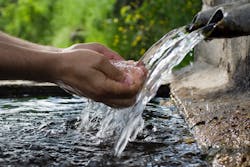BRISBANE, Australia — Dec. 15, 2015 — Many people living in remote communities of Australia have a lower life expectancy than those living metropolitan Australia, and one of the reasons for this could be lack of access to sufficient clean, safe water, according to a press release.
Public health engineer Dr. Jay Rajapakse and his research team at Queensland University of Technology gathered data on clean water issues in remote areas after the raw water supply in Georgetown, North Queensland, was found to contain excessively high levels of manganese and iron, noted the release
“The impact and concentration of contaminants that are naturally in the raw water supply are intensified during drought periods which are common in remote areas,” Dr. Rajapakse pointed out in the release.
“The Georgetown example has indicated that we need information on remote populations and water consumption rate, current types of water supply, treatment methods and water quality to compare with Australian safe water guidelines.”
Dr. Rajapakse said in the release that the gap in life expectancy at birth between non-Indigenous Australians and Aboriginal and Torres Strait Islander peoples was estimated at 11.5 years for males and 9.7 years for females.
Many factors contribute to lower life expectancy, including lack of access to primary health care and treatment, poverty and overcrowded housing. But limited access to safe water also has a substantial impact on basic health, stated the release.
“It’s not just drinking water that carries health dangers. Trachoma, for example, is a bacterial eye disease that can lead to blindness if not treated and is spread due to lack of clean water for washing,” Dr. Rajapakse said in the release.
“Australia is the only developed country where trachoma is still endemic and it is found almost exclusively in remote Aboriginal and Torres Strait Islander populations.
“Supplying piped water to households is one thing but the water supplied must be safe, without physical contamination from such things as mud (turbidity) and chemicals as well as water-borne pathogens,” he concluded in the release.
Dr. Rajapakse is currently working with an Australian industry partner to develop a simple disinfection method suitable for remote communities, reported the release.
You can find the entire release here.


